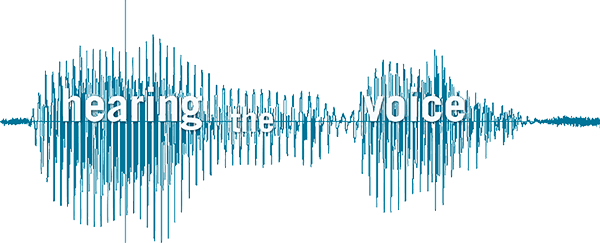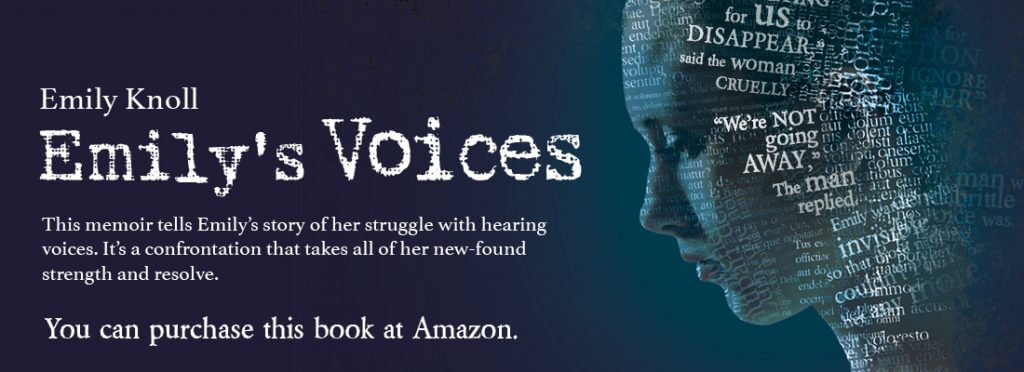Berta Britz is an experienced facilitator of Hearing Voices Network Groups, a board member of the US Hearing Voice Network, and recipient of the “Inspiration Intervoice Award“. In this post, Berta shares her reflections on Emily’s Voices, a thought-provoking memoir that charts Emily’s struggles with voice-hearing and her journey through the mental health system.
I enjoyed and valued reading Emily’s Voices by Emily Knoll. In this memoir, printed by Amazon in Great Britain, Emily describes her experience of hearing voices and the challenges she encountered in learning to make sense of her experiences. She writes with a direct honesty that invites a reader to follow along as she discovers her own path to a meaningful life. She describes intense experiences and emotions that felt overwhelming to her with a clear, controlled style.
As a young adult Emily’s voices discussed and judged her. They sounded like they were outside herself on the other side of a wall or above the ceiling. They stalked her. Emily’s sense of danger and insecurity was present from the age of two when her parents separated, and thereafter she carried a heightened sensitivity to the judgments of others. She developed a strong inner critic, demanding goals and the perseverance to achieve highly. Her own standards, developed in relation to anticipated judgement by others, presented barriers to self-acceptance and wholeness. Her energies were so focused on external standards that her own emotions were often curtailed. This wounded her and estranged her from her creative core as she struggled to avoid overwhelming anxiety.
Despite feeling haunted by an intense fear that her world could disintegrate at any moment, Emily used the nurturing and learning available from her grandfather, her grandmother, and later from good friends, teachers, and mental health professionals. She often explores the impact of the judgement of others on her self-esteem and identity. She retains the belief that her experiences were part of a mental illness best understood by a trusted professional. From that vantage point, she points out both what helped and hurt in her professional treatment and addresses the damage from social bias and stigma and from internalizing it. She offers her memoir to expand and deepen public perspectives on people who hear voices, and she demonstrates the cost incurred by individuals, families, and society from allowing low expectations to steal hope.
I appreciated most that Emily shared her own story rather than allowing her experience to be framed and filtered through the gaze of an external “expert” speaking on her behalf. I trust that she will continue to make meaning from her experience as her process continues. I thought that her emphasis on coping reflected the space she occupied while writing the memoir and not an endpoint, as the rest of her journey continues to unfold. I was struck by how powerfully her own gaze had been shaped by the medical, deficit-based narrative that dominates and so thoroughly infiltrates the gaze of most of us in western industrialized cultures. For this I felt sad.
Emily expressed a desire to fight “stigma,” but like so many of us, she failed to recognize that such bias is the consequence of having accepted a harmful framework that places authority for categorizing and dividing our diversity rather than locating us in a rainbow continuum of human multiplicity. She seems to align her perspective with that of Elyn Saks, law professor and author of The Center Cannot Hold, by distinguishing between those with diagnoses whom she calls “service users” whom she describes as “low functioning,” and contrasts them with those termed “high functioning,” a classification similar to those Saks refers to as “exceptional.” It grieves me that at the time of writing this memoir, Emily measured her own self-worth by using a yardstick based on inequality and caste. Yet, I understand that we all have been shaped by the dominant narratives in our culture, and to undo such fear-based learning is an ongoing task best undertaken communally. Together we can weave inclusive stories that celebrate diversity.
When referencing the Hearing Voices Network Movement (HVNM), Emily indicated her view that the HVNM elevates trauma above other ways of understanding the experience of hearing voices. While that may be a perspective carried by many individuals within the Movement, it counters the fundamental HVN principle that hearing voices is a human experience understood and defined by the person experiencing it. Emily’s assumption that hearing voices is a symptom to be fought or managed, reflects what she learned from those who diagnosed and re-diagnosed her. At various points, she reacted to her diagnosis being changed from bipolar, to schizophrenia, to schizoaffective, to borderline personality disorder as if those changes would predict different outcomes and a different sense of identity and worth. Diagnoses don’t capture human experience, and it is the wounding from accepting experts’ authority to impose such judgement that grieves me the most. The imprint of trusting the experts-by-training over one’s own wisdom and expertise is an imprint that has devastated many of us who have endured subordinating to a medical branding that perpetuates reductionist, fearful perspectives in our cultures. My own perspective is that we all learn and grow in relationship, and the most liberating relationships are those that most approximate equality and mutuality. It is when we become curious together that we can create new connections that elevate love over fear and open us to multiple ways of seeing and valuing ourselves and others.
Emily’s Voices is the story of an accomplished person—a person who now enjoys relationships with friends, playing cello in an orchestra, and work as a researcher. Her memoir offers a valuable window into her personal journey and prompts the reader to reflect on how she navigated experiences growing up in family, school, work, and mental health treatment—what helped and what hurt. Emily’s Voices challenges us to reconsider messages of hope and hopelessness that impact us all.
Emily’s Voices is available on Amazon and can be purchased here.
More about the reviewer:
Berta Britz is a consultant with Berta Britz Consulting, promoting listening and hearing for growing mutual understanding and opportunities for healing and wholeness. Her ministry – “Hearing Voices and Healing” – is under the care of the Central Philadelphia Monthly Meeting of the Religious Society of Friends. She is a member of Transforming Research on Psychosis Collaborative, ISPS and the Experts by Experience Committee of ISPS-US, and worked for nearly a decade in Montgomery County Pennsylvania for Creating Increased Connections. As a Certified Peer Specialist, Berta was instrumental in the introduction of the Hearing Voices Network Movement to the local community, and coordinated the Montgomery County HVN. She received the “Inspiration Intervoice Award 2016” at the World Hearing Voices Congress in Paris. A board member of HVN-USA, Berta is an experienced facilitator of Hearing Voices Network Groups and has presented in many venues in the US and internationally. She uses the liberation that she experienced in the international hearing voices community and in Taking Back Our Power Self-Help/Peer Support Hearing Voices Groups to inform collaboration among mental health clinicians, family members, and people with lived anomalous experiences, in order to grow capacity for understanding the experience of living and working with anomalous beliefs and voices. Her deepest passion is for creating spaces that welcome young people growing into their fullest selves.

